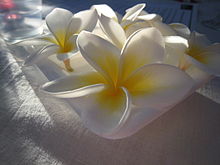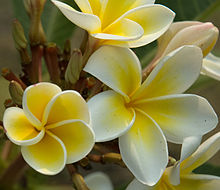Plumeria (common name Frangipani) is a genus of flowering plants of the family that includes Dogbane: the Apocynaceae. It contains 7-8 species of mainly deciduous shrubs and small trees. They are native to Mexico, Central America, the Caribbean, and South America as far south as Brazil but have been spread throughout the world's tropics.
Description
 Plumeria is related to the Oleander, Nerium oleander, and both possess a irritating, milky sap, rather similar to that of Euphorbia. Contact with the sap may irritate eyes and skin. Each of the separate species of Plumeria bears differently shaped alternate leaves, with distinct form and growth habits. The leaves of P. alba are quite narrow and corrugated, whereas leaves of P. pudica have an elongated shape and glossy, dark-green color. P. pudica is one of the ever blooming types with non-deciduous, evergreen leaves. Another species that retains leaves and flowers in winter is P. obtusa; though its common name is "Singapore," it is originally from Colombia.
Plumeria is related to the Oleander, Nerium oleander, and both possess a irritating, milky sap, rather similar to that of Euphorbia. Contact with the sap may irritate eyes and skin. Each of the separate species of Plumeria bears differently shaped alternate leaves, with distinct form and growth habits. The leaves of P. alba are quite narrow and corrugated, whereas leaves of P. pudica have an elongated shape and glossy, dark-green color. P. pudica is one of the ever blooming types with non-deciduous, evergreen leaves. Another species that retains leaves and flowers in winter is P. obtusa; though its common name is "Singapore," it is originally from Colombia.Plumeria flowers are most fragrant at night in order to lure sphinx moths to pollinate them. The flowers have no nectar, and simply dupe their pollinators. The moths inadvertently pollinate them by transferring pollen from flower to flower in their fruitless search for nectar.
Plumeria species may be easily propagated from cuttings of leafless stem tips in spring. Cuttings are allowed to dry at the base before planting in well-drained soil. Cuttings are particularly susceptible to rot in moist soil. Propagation can also be by tissue culture from cuttings of freshly elongated stems or aseptically germinated seed. Pruning is best accomplished in the winter for deciduous varieties, or when cuttings are desired.
.jpg/220px-Plumeria_rubra_(flowers).jpg%20) There are more than 300 named varieties of Plumeria. The genus, originally spelled Plumiera, is named in honor of the seventeenth-century French botanist Charles Plumier, who traveled to the New World documenting many plant and animal species. The common name "Frangipani" comes from an Italian noble family, a sixteenth-century marquess who invented a plumeria-scented perfume. Many English speakers also simply use the generic name "plumeria". In Hawaii, the name is "melia". In Sri Lanka, it is referred to as araliya and (in English) as the Temple Tree.
There are more than 300 named varieties of Plumeria. The genus, originally spelled Plumiera, is named in honor of the seventeenth-century French botanist Charles Plumier, who traveled to the New World documenting many plant and animal species. The common name "Frangipani" comes from an Italian noble family, a sixteenth-century marquess who invented a plumeria-scented perfume. Many English speakers also simply use the generic name "plumeria". In Hawaii, the name is "melia". In Sri Lanka, it is referred to as araliya and (in English) as the Temple Tree.In Culture
 These are now common naturalized plants in southern and southeastern Asia. In local folk beliefs they provide shelter to ghosts and demons. The scent of the Plumeria has been associated with a vampire in Malay folklore, the pontianak. They are associated with temples in both Hindu and Buddhist cultures.
These are now common naturalized plants in southern and southeastern Asia. In local folk beliefs they provide shelter to ghosts and demons. The scent of the Plumeria has been associated with a vampire in Malay folklore, the pontianak. They are associated with temples in both Hindu and Buddhist cultures.In several Pacific islands, such as Tahiti, Fiji, Samoa, Hawaii, New Zealand, Tonga, and the Cook Islands Plumeria species are used for making leis. In modern Polynesian culture, it can be worn by women to indicate their relationship status - over the right ear if seeking a relationship, and over the left if taken.
.jpg/220px-Plumeria_(Frangipani).jpg) P. alba is the national flower of Nicaragua and Laos, where it is known under the local name "Sacuanjoche" (Nicaragua) and "Champa" (Laos).
P. alba is the national flower of Nicaragua and Laos, where it is known under the local name "Sacuanjoche" (Nicaragua) and "Champa" (Laos).In Bangladeshi culture most white flowers, and, in particular, plumeria (Bengali, chômpa or chãpa), are associated with funerals and death.
In the Philippines and Indonesia, Plumeria, which is known in Tagalog as calachuchi, is often associated with ghosts and graveyard. Plumerias are often planted on cemetery grounds in both countries. Balinese Hindus use the flowers in their temple offerings.
In Hindu mythology, there is a saying “Hey Champa you have three qualities color, beauty, and fragrance, but the only thing you lack is that honey-bees never sit on you”; "roop tajey to Radhikey, or bhanwar Krishna ko daas, is mariyaadey ke liye bhanwar na aaye pass" (the beauty of champa is compared to Radhika, who is wife of lord Krishna and honey-bees are servants of Lord Krishna and this is the reason honey-bees don't sit on the champa flower.)
In Sri Lankan tradition, Plumeria is associated with worship. One of the heavenly damsels in the frescoes of the 5th-Century rock fortress Sigiriya holds a 5-petalled flower in her right hand that is indistinguishable from Plumeria. In Eastern Africa, frangipangi are sometimes referred to in Swahili love poems.
Source, Images: http://en.wikipedia.org/wiki/Plumeria













0 comments:
Post a Comment